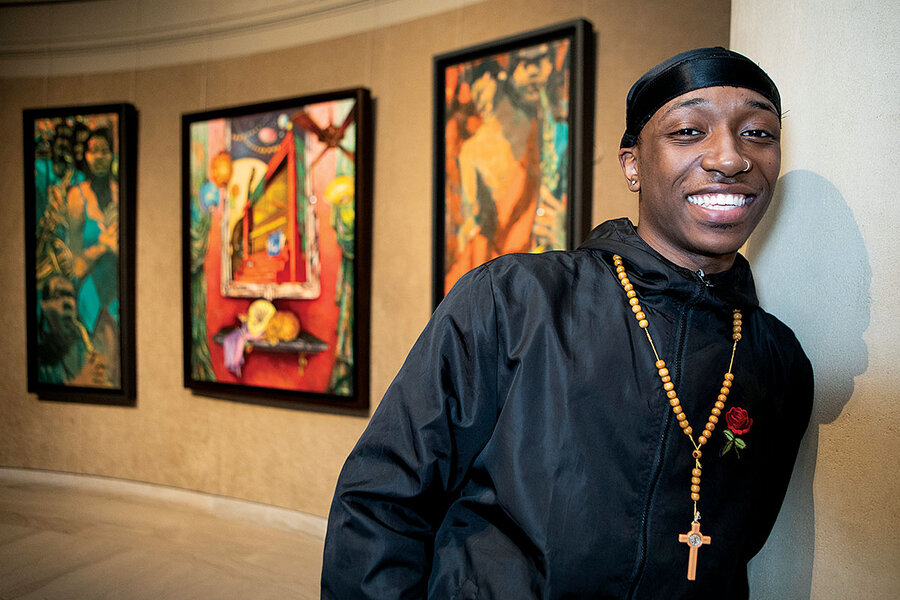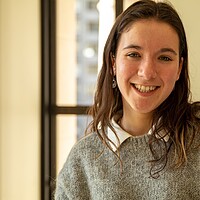What if curators were teens? Museums try it.
Loading...
| Boston
When a group of young people was asked to curate an exhibition about black artists at Boston’s Museum of Fine Arts, the group chose to focus on the plurality of black experiences.
Jadon Smith wanted viewers to “see the beauty in blackness,” but he also wanted to inspire young people to consider careers in the art world. He says if he could do it – with no art experience – then so can they. “I’m a city kid, just like them,” he says.
Why We Wrote This
What role can young people play in the future of museums? As arts organizations look ahead, incorporating diverse views is becoming more of a priority.
“Black Histories, Black Futures” is the museum’s first exhibition curated entirely by high school students. It is the culmination of a partnership with local youth empowerment organizations, and reflects a growing trend, one that has museums working to engage and represent a more diverse population within the field of fine art. (The MFA is currently closed, but a “Making of” video about the exhibition is available online.)
“This institution is 150 years old. And so what does that mean for young people? Where do young people belong in such an old institution?” says Layla Bermeo, an associate curator at the MFA. “This project really tried to argue that young people belong in the center.”
Jadon Smith steps closer to his favorite painting by Archibald Motley, carefully examining the details he’s looked at many times before, a smile from ear to ear. At the center of the piece, five elegant women dressed in their Sunday best sit in a restaurant. One woman, hidden in the background, catches his attention.
“Women are the centerpiece of the whole entire painting,” says Jadon, a junior at John D. O’Bryant School of Mathematics and Science, during a visit to Boston’s Museum of Fine Arts in early March. “They’re supposed to be there to be seen. Don’t ignore them. Notice that they’re there, appreciate the fact that they’re there.”
Jadon is one of six local teens selected to craft “Black Histories, Black Futures” – the museum’s first exhibition curated entirely by high school students. The MFA’s exhibition, the culmination of a partnership with local youth empowerment organizations, reflects a growing trend, one that has museums working to engage and represent a more diverse population within the field of fine art. Including young people in the curation process not only trains the next generation of curators, say museum staffers, but it also helps aging institutions display refreshing and inclusive exhibitions inspired by the young curators’ own experiences.
Why We Wrote This
What role can young people play in the future of museums? As arts organizations look ahead, incorporating diverse views is becoming more of a priority.
“This institution is 150 years old. And so what does that mean for young people? Where do young people belong in such an old institution?” says Layla Bermeo, an associate curator at the MFA. “This project really tried to argue that young people belong in the center.”
Engaging teens across the U.S.
Some museums are connecting directly with high schools to include students. The San Francisco Museum of Modern Art, for example, partners with two high schools for its young curators program, according to Julie Charles, director of education at SFMOMA. The Teen Creative Agency program at Chicago’s Museum of Contemporary Art has been so successful that the museum restructured its building to include a glass room at its center so the public can see how the students are being taught. (While the museum is currently closed, the teens have been using the MCA’s Instagram account to highlight local artists and designers.) The Cleveland Museum of Art has a teen curation team called Currently Under Curation that creates exhibits for both the museum and local libraries.
“I think at least the field is acknowledging it and understanding that we need to take action in order to really change things,” says Melissa Higgins-Linder, director of learning and engagement at the Cleveland Museum of Art. Calling the programs a first step, she says she hopes the field is “recognizing the real and true value of those perspectives and not just paying lip service to them.”
The current opportunities build on ongoing efforts. In 1993, the Getty Foundation in Los Angeles founded the Getty Marrow Undergraduate Internships initiative. Since then, the program has involved more than 3,000 interns from underrepresented communities. The Andrew W. Mellon Foundation in New York has funded undergraduate curatorial fellowship programs at a number of American art museums since 2013. In 2017, the Ford Foundation and the Walton Family Foundation also partnered to launch an initiative in which 20 museums across the country received grants to support the diversification of staff and leadership.
“For museum professionals that are supervising the interns, it provides them with new perspectives, another voice that can be represented at their institutions,” says Selene Preciado, program assistant at the Getty Foundation. Along with mentoring and guiding the students, the opportunity also helps in diversifying the field, she says. “It’s a slow process. But fortunately, because we’ve been around for such a long time, we are able to see the fruits of that.”
In Boston, “Black Histories, Black Futures” highlights works by well-known 20th-century artists of color, as well as local artists, some presented in the MFA for the first time. Besides the opportunity to offer something new for its 150th anniversary, the exhibit is a way for the MFA to fulfill a goal of being welcoming and inclusive – an aim that took a hit last spring when a group of minority students said they were harassed by security officers during their first visit to the museum.
Shared experiences
In creating “Black Histories, Black Futures” the student curators had a lot of freedom. The only prerequisite was to showcase black artists, says Ms. Bermeo. The interns decided to make sure they were portraying the plurality of black experiences.
Jadon, for example, wants viewers to “see the beauty in blackness,” but he also wants to inspire young people to consider careers in the art world. He says if he could do it – with no art experience – then so can they. “I’m a city kid, just like them,” he says.
All the pieces in “Black History, Black Future” focus on powerful images of black communities. “It’s a completely different kind of exhibition,” says Ms. Bermeo. “This one really centers the types of objects that this group of young people wanted to see here in the museum, works of art that reflected their experiences versus maybe a kind of more art historical one that would grow out of one of my projects or one of the other curators’ projects here at the museum.”
The works in the exhibit – which is expected to run through June 20, 2021, though the MFA is currently closed due to the coronavirus outbreak – are drawn largely from the MFA’s own collection, supplemented by loans from the Museum of the National Center for Afro-American Artists. (Some of the pieces can be seen in a “Making of” video on the museum’s website.) The exhibit is divided into four thematic sections: “Ubuntu: I Am Because You Are,” celebrating the black community; “Welcome to the City,” focusing on urban scenes; and “Normality Facing Adversity” and “Smile in the Dark” both focusing on images of dignified black families before and after the civil rights movement.
One of the great visual chroniclers of 20th-century America, Motley – who painted Jadon’s favorite, titled “Cocktails” – was known for depicting the blossoming of black social life and jazz culture in vibrant city scenes. “To me [“Cocktails”] was the embodiment of just Ubuntu itself, just community building, showing that there’s more to black culture than just the civil rights movements,” says Jadon. “That shouldn’t be the first thing to pop in your head.”










